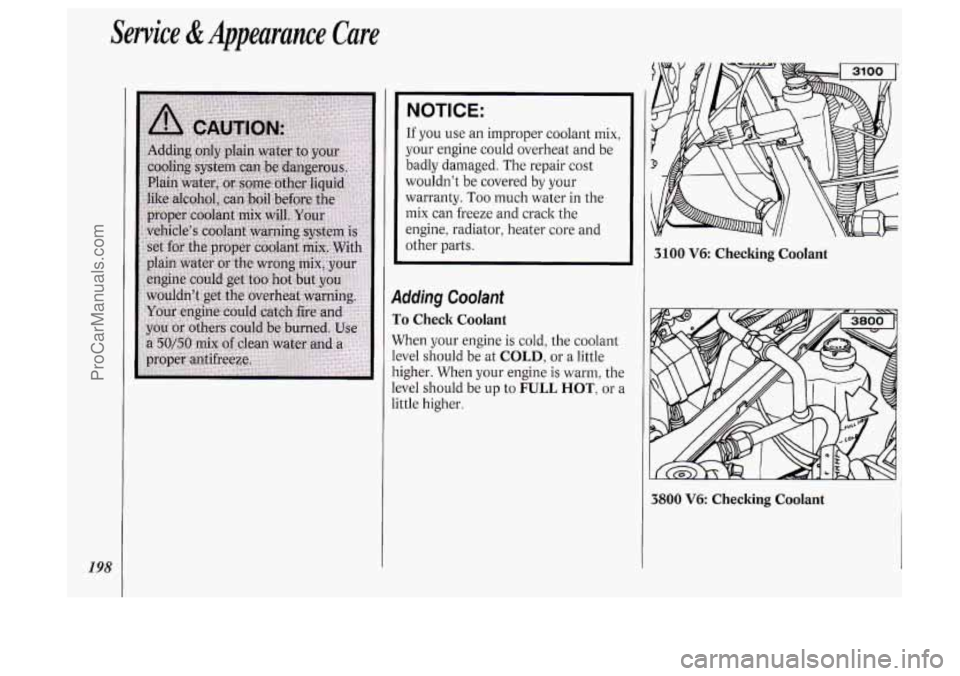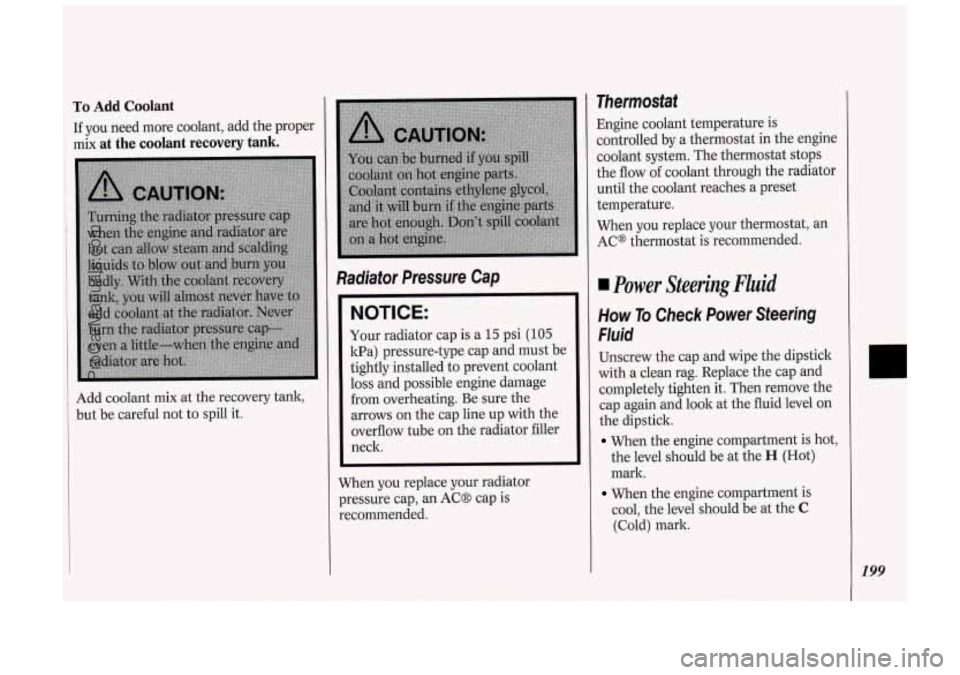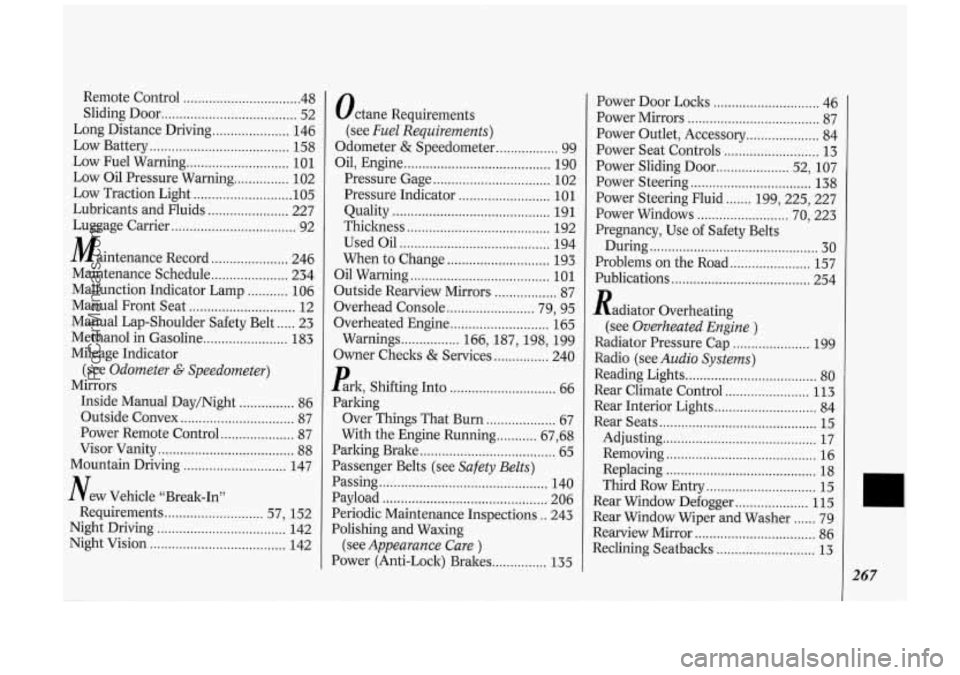1994 OLDSMOBILE SILHOUETTE radiator
[x] Cancel search: radiatorPage 200 of 276

Service &Appearance Cure
NOTICE:
198
If you use an improper coolant mix,
your engine could overheat and be
badly damaged. The repair
cost
wouldn’t be covered by your
warranty. Too much water in the
mix can freeze and crack the
engine, radiator, heater core and
other parts.
Adding Coolant
To Check Coolant
When your engine is cold, the coolant
level should be at
COLD, or a little
higher. When your engine is warm, the
level should be up to
FULL HOT, or a
little higher.
3100 V6: Checking Coolant
3800 V6: Checking Coolant
ProCarManuals.com
Page 201 of 276

To Add Coolant
If you need more coolant, add the proper
mix
at the coolant recovery tank.
Add coolant mix at the recovery tank,
but be careful not to spill it.
Radiator Pressure Cap
NOTICE:
Your radiator cap is a 15 psi (105
kPa) pressure-type cap and must be
tightly installed to prevent coolant
loss and possible engine damage
from overheating. Be sure the
arrows on the cap line up with the
overflow tube on the radiator filler
neck.
When you replace your radiator
pressure cap, an AC8 cap is
recommended.
Thermostat
Engine coolant temperature is
controlled by a thermostat in the engine
coolant system. The thermostat stops
the flow of coolant through the radiator
until the coolant reaches a preset
temperature.
When you replace your thermostat, an
AC@ thermostat is recommended.
Power Steering Fluid
How To Check Power Steering
Fluid
Unscrew the cap and wipe the dipstick
with a clean rag. Replace the cap and
completely tighten it. Then remove the
cap again and look at the fluid level on
the dipstick.
When the engine compartment is hot,
the level should be at the
H (Hot)
mark.
When the engine compartment is
cool, the level should be at the
C
(Cold) mark.
199
ProCarManuals.com
Page 203 of 276

NOTICE:
When using concentrated washer
fluid, follow the manufacturer’s
instructions for adding water.
Don’t mix water with ready-to-
use washer fluid. Water can cause
the solution to freeze and damage
your washer fluid tank and other
parts of the washer system. Also,
water doesn’t clean as well as
washer fluid.
Fill your washer fluid tank only %
full when it’s very cold. This
allows for expansion, which could
damage the tank
if it is
completely full.
Don’t use radiator antifreeze in
your windshield washer. It can
damage your washer system and
paint.
I
Brakes
Brake Master Cylinder
Your brake master cylinder is here. It is
filled with DOT-3 brake fluid.
There are only
two reasons why the
brake fluid level in your master cylinder
might go down. The first is that the
brake fluid goes down to an acceptable
level during normal brake lining wear.
When new linings are put in, the fluid
level goes back up.
The other reason is that fluid is leaking
out of the brake system. If it is, you
should have your brake system fixed,
since a leak means that sooner or later
your brakes won’t work well, or won’t
work at all.
So, it isn’t a good idea to
“top off’’ your brake fluid. Adding brake fluid
won’t correct a leak. If you add
fluid when your linings are worn, then
you’ll have too much fluid when you get
new brake linings. You should add (or
remove) brake fluid, as necessary, only
when work is done on the brake
hydraulic system.
When your brake fluid falls to a low
level, your brake warning light will
come on. See
Brake System Warning
Light
in the Index.
What to Add
When you do need brake fluid, use only
DOT-3 brake fluid
- such as Delco
Supreme
ll@ (GM Part No.1052535).
Use new brake fluid from a sealed
201
ProCarManuals.com
Page 240 of 276

Maintenance Schedule
238
Explanation of Scheduled
Maintenance Services
Following are explanations of the
services listed in Schedule I and
Schedule 11.
The proper fluids and lubricants to use
are listed in Section D. Make sure
whoever services your vehicle uses
these. All parts should be replaced and
all necessary repairs done before you or
anyone else drives the vehicle.
ITEM
NO. SERVICE
1. Engine Oil and Filter Change* -
Always use SH or SG Energy
Conserving
I1 oils of proper viscosity.
The
“SH” or “SG” designation may
be shown alone
or in combination
with others, such as “SH/CD,”
“SH,
SG, CD,” “SG/CD,” etc. To
determine the preferred viscosity for
your vehicle’s engine (e.g.,
SAE 5W-
30 or SAE 10W-30), see
Engine Oil
in the Index.
2. Chassis Lubrication - Lubricate
suspension and steering linkage.
Lubricate the transaxle shift linkage,
and parking brake cable guides,
underbody contact points and
linkage.
3. Tire and Wheel Rotation and
Inspection
- For proper wear and
maximum tire life, rotate your tires
following the instructions in this
manual. See
Tires, Inspection E.
Rotation in the Index. Check the
tires for uneven wear
or damage. If
you see irregular or premature wear,
check the wheel alignment. Check for
damaged wheels also.
Engine Accessory Drive Inspection
- Inspect the drive belt for cracks,
fraying, wear and proper tension.
Replace as needed.
I
Cooling System Servicee - Drain,
flush and refill the system with new
or approved recycled coolant
conforming to GM Specification
I
1825M. Keep coolant at the proper 1
mixture as specified. See Coolant in
the
Index. This provides proper
freeze and boil protection, corrosion
I
inhibitor level and maintains proper ’
engine operating temperature.
Inspect hoses
and replace if they are
cracked, swollen or deteriorated.
Tighten screw-type hose clamps.
Clean the outside of the radiator and
air conditioning condenser. Wash tht
pressure cap and neck.
To help ensure proper operation, we
recommend
a pressure test of both the
cooling system and the pressure cap.
ProCarManuals.com
Page 269 of 276

Remote Control ................................ 48 .. Sliding Door ..................................... 52
Long Distance Driving
..................... 146
Low Battery
...................................... 158
Low Fuel Warning ............................ 101
Low Oil Pressure Warning
............... 102
Low Traction Light
........................... 105
Lubricants and Fluids ...................... 227
Luggage Carrier
.................................. 92
Maintenance Record
..................... 246
Maintenance Schedule
..................... 234
Malfunction Indicator Lamp
........... 106
Manual Front Seat
............................. 12
Manual Lap-Shoulder Safety Belt
..... 23
Methanol in Gasoline
....................... 183
Mileage Indicator
Mirrors (see
Odometer G. Speedometer)
Inside
Manual Day/Night ............... 86
Outside Convex
............................... 87
Power Remote Control
.................... 87
Mountain Driving
............................ 147
New Vehicle “Break-In”
Night Driving
................................... 142
Night Vision
..................................... 142
Visor Vanity
..................................... 88
Requirements ........................... 57.
152 Octane
Requirements
(see
Fuel Requirements)
Odometer & Speedometer ................. 99
Oil. Engine
........................................ 190
Pressure Gage
................................ 102
Pressure Indicator
......................... 101
Quality
........................................... 19 1
Thickness ....................................... 192
Used Oil
......................................... 194
When to Change
............................ 193
Oil Warning
...................................... 101
Outside Rearview Mirrors ................. 87
Overhead Console
........................ 79. 95
Overheated Engine
........................... 165
Warnings ................ 166. 187. 198. 199
Owner Checks
& Services ............... 240
Rrk. Shifting Into
............................. 66
Parking Over Things That Burn
................... 67
Parking Brake
..................................... 65
Passenger Belts (see
Safety Belts)
Passing .............................................. 140
Periodic Maintenance Inspections
.. 243
Polishing and Waxing
With
the Engine Running
........... 67. 68
Payload
............................................. 206
(see
Appearance Care )
Power (Anti-Lock) Brakes ............... 135 Power
Door Locks
............................. 46
Power Mirrors
.................................... 87
Power Outlet. Accessory
.................... 84
Power Seat Controls
.......................... 13
Power Sliding Door .................... 52. 107
Power Steering
................................. 138
Power Steering Fluid ....... 199.225. 227
Power Windows
......................... 70. 223
During
.............................................. 30
Problems on the Road
...................... 157
Publications
...................................... 254
Pregnancy.
Use
of Safety Belts
Radiator Overheating
(see
Overheated Engine )
Radiator Pressure Cap ..................... 199
Radio (see
Audio Systems)
Reading Lights .................................... 80
Rear Climate Control
....................... 113
Rear Interior Lights ............................ 84
Rear Seats
........................................... 15
Removing ......................................... 16
Replacing
......................................... 18
Third Row Entry .............................. 15
Rear Window Defogger .................... 115
Rear Window Wiper and Washer
...... 79
Rearview Mirror
................................. 86
Reclining Seatbaclts
........................... 13
.. Ad~ustmg .......................................... 17
267
ProCarManuals.com